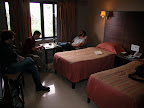
Always on the hunt for new and exciting ways to blow our money, Krissy and I decided to buy a Samsung Galaxy Tab 10.1 recently. We had been looking to buy a tablet for several months, but wanted to wait until the Honeycomb version of the Android OS was out as it was the first Android OS designed specifically for tablets. Previous Android-based tablets were built on a beefed-up version of the phone OS. Even though we're intimately familiar with the Android OS, having spent a lot of time with our HTC Evos, the Tech Writer geek side of us just HAD to RTFM (those who know what that means know, those that don't, well, don't). We were lucky it didn't end up in the trash with the packaging, but more about that later. I'm going to analyze the manual based on its content and the design.
Content
As a Getting Started Guide, its primary function is to give users some basics of operation. The manual of the Galaxy Tab is certainly no different. It walks the reader through the basic function of the tablet: charging the battery, turning it on and off, turning on wi-fi, using the navigation "buttons", etc. Organizationally speaking, the content has a few sections that seemed out of place as there are two pages that are found in the back which should have been placed a bit earlier. The first is a page that lists all of the Google Mobile services that require a Google account. In my opinion, this information is better suited before the page that discusses adding a Google Account. Listing these services before that step might encourage folks who don't currently have a Google Account to sign up for one. The explanation for Browsing the Web is also located in the back of the manual. Considering that one of the primary (if not THE primary) reasons for purchasing a tablet computer is for web surfing, this step could've been given more urgency. The steps themselves are very clear and concise. In fact, not a single instruction requires more than 5 steps. With today's Millenial (aka Short Attention Span) Generation, the brevity is sure to befit the majority of its audience. As we set up our tablet, the instructions were accurate and easy-to-follow.
Design
 My fear of losing the manual stemmed entirely from its diminutive size. At a minuscule 4"x 2.5", the manual is only slightly larger than a business card. For those of us with impaired vision, the Lilliputian sized font was extremely difficult to read. Then again, the target audience probably all have perfect vision either due to youth or Lasik. Aside from the scale, the guide is well designed. All of the instruction headers are encompassed in "tabs" similar to those found on Google's Chrome browser. This makes it easy to locate each of the topics. The instructions are all accompanied by a variety of illustrations - many of which have visual callouts to direct the reader to some of the icons used for various tasks.
My fear of losing the manual stemmed entirely from its diminutive size. At a minuscule 4"x 2.5", the manual is only slightly larger than a business card. For those of us with impaired vision, the Lilliputian sized font was extremely difficult to read. Then again, the target audience probably all have perfect vision either due to youth or Lasik. Aside from the scale, the guide is well designed. All of the instruction headers are encompassed in "tabs" similar to those found on Google's Chrome browser. This makes it easy to locate each of the topics. The instructions are all accompanied by a variety of illustrations - many of which have visual callouts to direct the reader to some of the icons used for various tasks.
Overall, the guide satisfies the core requirements of effective guide writing. It is well-organized, informative, clear, concise, and effectively uses design elements to guide the reader through all of the procedures and all in a package roughly the size of an opened matchbook.










